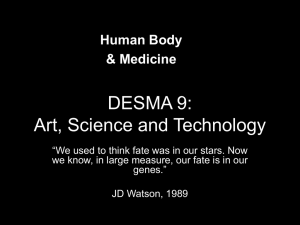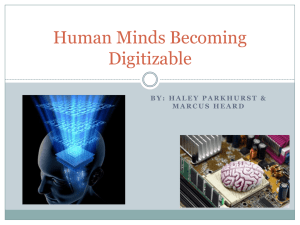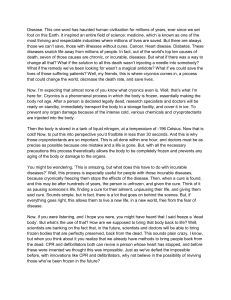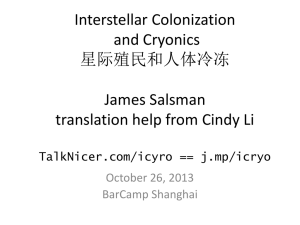Applying Narrative Structure to Your Paper Workshop Amanda Yang
advertisement
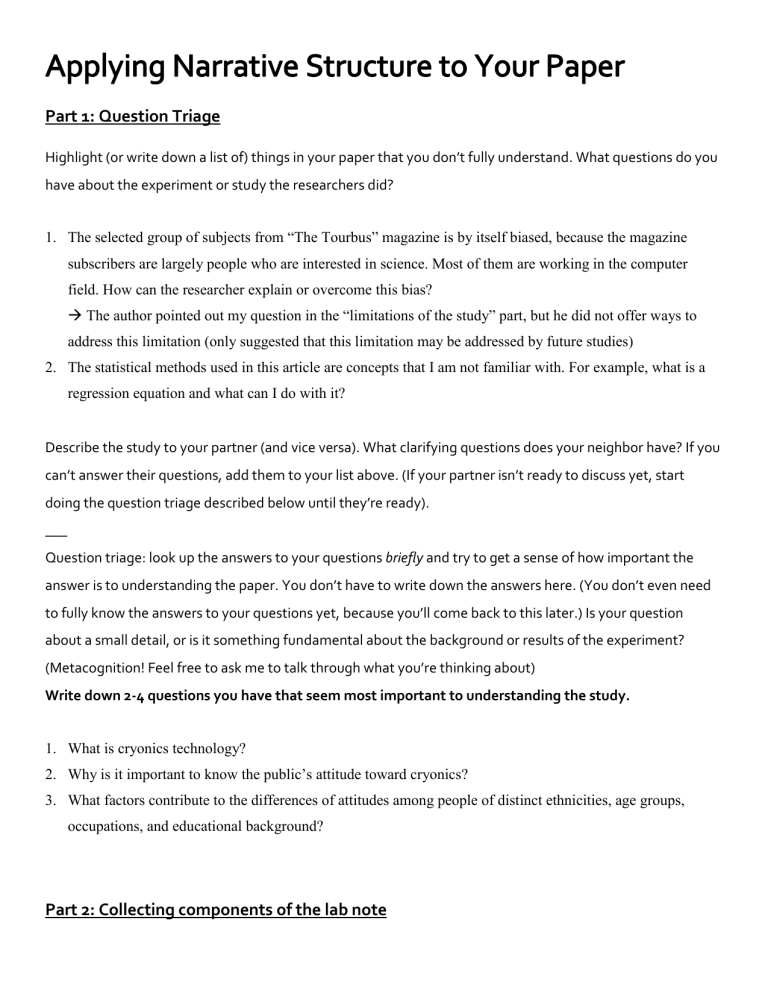
Part 1: Question Triage Highlight (or write down a list of) things in your paper that you don’t fully understand. What questions do you have about the experiment or study the researchers did? 1. The selected group of subjects from “The Tourbus” magazine is by itself biased, because the magazine subscribers are largely people who are interested in science. Most of them are working in the computer field. How can the researcher explain or overcome this bias? The author pointed out my question in the “limitations of the study” part, but he did not offer ways to address this limitation (only suggested that this limitation may be addressed by future studies) 2. The statistical methods used in this article are concepts that I am not familiar with. For example, what is a regression equation and what can I do with it? Describe the study to your partner (and vice versa). What clarifying questions does your neighbor have? If you can’t answer their questions, add them to your list above. (If your partner isn’t ready to discuss yet, start doing the question triage described below until they’re ready). ___ Question triage: look up the answers to your questions briefly and try to get a sense of how important the answer is to understanding the paper. You don’t have to write down the answers here. (You don’t even need to fully know the answers to your questions yet, because you’ll come back to this later.) Is your question about a small detail, or is it something fundamental about the background or results of the experiment? (Metacognition! Feel free to ask me to talk through what you’re thinking about) Write down 2-4 questions you have that seem most important to understanding the study. 1. What is cryonics technology? 2. Why is it important to know the public’s attitude toward cryonics? 3. What factors contribute to the differences of attitudes among people of distinct ethnicities, age groups, occupations, and educational background? Part 2: Collecting components of the lab note Who would you like to be the audience for your lab note? (It doesn’t have to be the same group of people that you wrote about in your audience summary, though that may be easier.) People who are interested in cryonics. They can be college students and people who work at cryonics institutions. As a reminder, lab notes have four sections: The background, where the author explains some essential information about a field of research that the reader will need to know to understand this experiment. The trigger, which is usually a new question that the authors have identified that no one knows the answer to. The action, which is the design, execution, and analysis of an experiment that answers the trigger question. And the change, which are either the results of the experiment that answer the trigger question, or the results that show that the experiment was flawed. _____ Background (You’ll find this in the Introduction) You don’t need to evaluate what’s the most important at this stage. Just make a list of the stuff you’re seeing. Concepts: List of things that are important for understanding this field of research Cryonics (its current findings and future development), public attitude toward this concept, reasons why this field is worth researching for Engagement: List of things that are important for engaging in this field of research (What’s exciting about this research? Why is it important? Where might a reader form an opinion? How else did you “participate” when you read this paper?) Right now, the public has many diverse ideas toward the development of cryonics. Since this concept largely attracts people who are sci-fi fans and followers of cutting-edge technologies, misunderstandings emerge among people who are not in these categories. The misunderstandings, even resentment, among public audiences create obstacles for this concept to be proliferated. As science and technology become more commonplace in people’s lives, it is crucial to recognize the existence of cryonics because it gives people another chance to experience the feeling of “living” and this world. Therefore, this research’s findings about how people think of this technology offers valuable insight for the developers of cryonics. Modify your lists: Consider adding more for audience understanding Are the people in your chosen audience likely to be very familiar with all of the items on your list on concepts? Is there anything you might want to explain before you get to the concepts on the list? (E.g. If I were summarizing an article on carbon emissions for children, I might want to first explain what gases are.) I will explain to the sci-fi fans again about the detailed mechanism of cryonics, because they might know little about the operation of cryonics even though they read it in science fictions on a rough scale. Prioritize the stuff that’s most important What do you think are the most important concepts for understanding this paper? If you’re not sure, that’s totally fine—your answer will likely change as you work on the other sections of the lab note. Make some sort of identifying mark next to the concepts that you think are likely to be more important. Then, make a similar mark next to the items that seem most important on the Engagement list. Consider which of these engaging elements might be the best strategy to draw your reader in to your narrative. ___ Trigger (You’ll find this in the introduction) The introduction of a research paper typically has a few paragraphs about the field of research that contextualizes this experiment. This summary usually starts very broad (starting with a topic like “Why climate change is important to the world”) and gets more specific (something like “Why carbon emissions generated by a specific kind of landfill in a specific country are important”) Then, the introduction usually transitions into a description of the experiment the researchers did in this paper. To make the transition from summarizing the field to describing the experiment, researchers usually write some kind of gap statement. The gap statement often looks something like this: “Though previous research shows ____, we still don’t know ____.” The gap statement may look similar to this structure, or it might look different. Find a sentence or two that you think might be the gap statement and write them here. Or, if there is no sentence that’s clearly a gap statement, make your best guess at what that gap statement could be. Feel free to ask me for help. This paper does not have an explicit gap statement, but the rough logic looks like this in the introduction part: cryonics firms and research institutions have failed to convince people about the credibility of cryonics explain the procedures necessary to develop successful “people-freezing” technology illustrate the lack of hope in the field of cryonics some possible contributing factors for the lack of hope and other methods to “market” cryonics points out the function of this article, that is to address some controversy related to cryonics by surveying people about their familiarity and attitudes toward cryonics Action (You’ll find this in the Methods and Results) What is the design of this experiment? How, where, and when do the researchers carry it out? How do they analyze the data? Starting with the methods, create a list, diagram, or sketch in which you identify the major steps of doing this experiment. If you don’t understand what the researchers did, consider writing out a daisy chain (as discussed in class) of the section you don’t understand. (Researchers are typically trying to write the methods and results sections as concisely as possible—they’re not always clear to a reader.) Then, in the results section, identify 2 or 3 of the results that you think are most important. Check with yourself that you understand what this result means and how the researchers got to it. The experiment involved in the article is a correlational study that attempts to analyze the relationship with the factors relevant with people’s familiarity and attitude. Participants are chosen from the subscribers of the “Tourbus” magazine. There are many independent variables: gender, age (adults and children), marital status, ethnicity, education, income, occupation, and religion. The research team designed some questions to survey their participants. Questions include “how familiar you would say you are with Cryonics compared to the average person”, “what you think is the estimate of the number of people being cryonically suspended”, etc. Participants are also given a quiz section, which includes questions about the facts about cryonics, to complete. Change (You’ll find this in the Conclusion) What is the most important thing the researchers found, and why is it important? (this may be one of the results you identified in the last section, or it may be a concluding remark that summarizes a few of the results.) In its small way, how does this result *change the world*? List out a few possible answers here. Your answers should be informed by the conclusion of the paper, but your opinion is also important here. Why do you think the study is important? Findings show that people often overestimate the expense of cryonics. Men are more interested in the development of cryonics than women, who are concerned with how to adapt to the new environment after one wakes up in the future. People who are Agnostics and Atheists are more likely to accept cryonics than people with other religious affiliations. Most importantly, people within age from 24 to 34 and over 65 shows less interest in cryonics than other age groups, which challenges my assumption that young adults are more interested in cryonics. Part 3: Investigating your triaged questions Return back to the Question Triage you did at the beginning of this exercise. Do you still think that the questions you marked are the most important questions? A question is likely to be more important if it’s something that you returned to as you were thinking about each section of your lab note. Alternatively, if a new concept or word was introduced once and never appeared again, it’s probably less important (though that’s not a guarantee.) Fill out the following table Questions you still want answers to: Questions you’ll set aside for now: The selected group of subjects from “The Same. These two questions are not important Tourbus” magazine is by itself biased, because regarding the article’s main research direction. the magazine subscribers are largely people who are interested in science. Most of them are working in the computer field. How can the researcher explain or overcome this bias? The author pointed out my question in the “limitations of the study” part, but he did not offer ways to address this limitation (only suggested that this limitation may be addressed by future studies) The statistical methods used in this article are concepts that I am not familiar with. For example, what is a regression equation and what can I do with it? Look up some of the answers to whichever questions you think are most important. Take notes on what you find here. If you find yourself going down a rabbit hole (i.e. if looking up one concept leads to looking up many more concepts, until you’re more confused than ever) ask me for help! Part 4: Put it together in your lab note rough draft It will be valuable to you to have a first draft that is messy. If you write a lab note that you believe is perfectly polished, it will make it harder for you to complete the upcoming assignments. So, for this first draft, please focus on: Extremely clear and simple explanation of the science (don’t worry about sounding professional at this point). Consider structuring your writing as a daisy chain, so the transitions between topics (and sentences and paragraphs) is clear. Having at least something for all four sections. It’s okay if you’ve written too much or too little for any section, because that’s the kind of thing you can work on in peer review. The total piece will be about a page long, but don’t worry too much about that right now. My key question is “when and how human cryonics technology will become possible in the future”. Since this concept is known mostly by sci-fi lovers, of which young adults are the majority, and people who works in this field, I targeted my audience to college students. To testify my hypothesis that college students are more acceptable to and familiar with the concept of cryonics, I chose a journal article, “An exploratory survey examining the familiarity with and attitudes toward cryonic preservation”, which aims to find out about the public’s attitude toward the current development and potential of cryonics. People of bachelor’s degree are included in the subject group of this research, which offers evidence to verify my hypothesis. To understand this article, there are two aspects of cryonics that I need to clarify: the operation of cryopreservation and the current development of this technology. The cryopreserving procedure involves one team of people using ice water to cool down one individual, put the individual into a sealed container, transport the person to a professional facility, and place he or she into a liquid nitrogen vapor chamber, which maintains its temperature at 320 degree Fahrenheit. Nowadays, scientists face obstacles in the technology of unfreezing humans without hurting any cells or organs, which requires further discovery of the human body at nano-level. Researchers of this article conducted a correlational study that analyzes the relationship between people’s demographic background, including gender, age, marital status, ethnicity, education, income, occupation, and religion, and their familiarity and attitude toward cryonics. Participants are chosen from the subscribers of the “Tourbus” magazine. All the subjects are asked question about their estimate of cryonics’ potential and their willingness to engage in it. This research shows that people of age 24 to 35 and over 65 have less interest in cryonics than other age group because they are more concerned about family stability and other living issues. This supports my argument that college students (age ranges from 18 to 22) are more interested in and familiar with cryonics.
